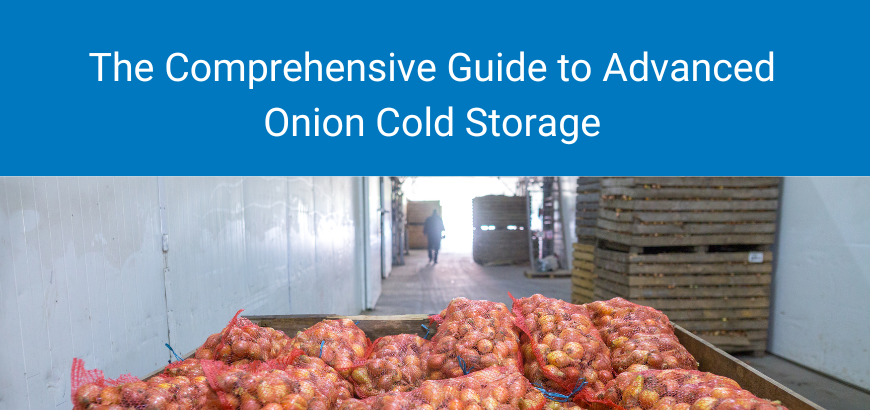The Comprehensive Guide to Advanced Onion Cold Storage

Admin
September 25, 2023


September 25, 2023

Onion is an important agricultural commodity, that not only finds extensive applications in culinary traditions throughout the world but has also emerged among the fastest-growing crops in the last few years. In fact, the estimated production of onions during 2022—23 is around 31.8 MT, higher than 31.7 MT in the last year. However, post-harvest losses are significant, impacting several stakeholders including farmers, traders, exporters, and consumers. With an impetus on advanced onion cold storage, efforts are being made to reduce post-harvest losses and address the supply-demand gap.
In this article, we will delve into cold storage for onions, how they work, the investments required, and much more.
In India, major onion-producing states include Maharashtra, Karnataka, Madhya Pradesh, Bihar, Gujarat, Andhra Pradesh, Rajasthan, Telangana, and Haryana. Around 50 to 60% of the crop is produced in the rabi season, while the remaining 40 to 50% is produced in kharif or late kharif season.
Some of the prominent onion varieties include the following:
Other onion varieties suitable for export in European countries include Tana F1, Granex 55, HA 60, Arad-H, Suprex, and Granex 429.
Post-harvest management includes effective methods for sorting, handling, storing, packaging, and transporting agricultural commodities after harvest. It is critical for maintaining nutrition and the quality of the produce for the long term.
Storage losses usually comprise physiological loss in weight (PLW), i.e.
These losses can be minimized by harvesting the onion crop at the right time, properly curing onion bulbs, and storing them at the desired temperature and humidity conditions. Additionally, for effective long-term storage, you may need to look at other factors such as the size of the bulb, cultivar type, cultivation method, time of harvest, field curing, top removal, drying, grading, packaging, and storage conditions.
The majority of post-harvest losses are observed at whole and retail level.
Let us look at all the necessary steps that are undertaken during post-harvest for long-term storage of onions.
Curing is the drying process for dehydrating the neck and external scale leaves of the bulbs to avoid the loss of moisture. This also reduces decay during storage.
Curing requires heat, low humidity, and good air circulation. For the process, onions can be collected and stacked in a warm, covered area with good ventilation, or they can tied at the top in bunches and hung on a horizontal pole in a ventilated, shaded area.
Curing in shaded areas enhances the colour of the bulb and also decreases loss during storage.
After processing, onions are graded manually before storage. Sorting and grading done prior to storage help reduce losses and post-storage yields better prices. Onions are usually graded on the basis of their size—the bigger the better.
A look at the AGMARK standards for onions.
Image source: APEDA
Usually, limited-size packaging is used for easy handling of the product during transit but it may vary depending on the purpose and demand. For onions, primarily jute bags are used for shipping or transportation but gunny bags, plastic netted bags or plastic and wooden baskets are also used for better storage.
It is important to ensure that bulbs for storage are free from any cuts. Additionally, they must not be released from over 6 feet on a non-resilient surface. The recommended height is 2 to 2.5 meters for arranging onions in a truck or store.
Before storage, onions should be dried effectively either in open fields or through artificial methods. This is crucial for both consumption and seed production. Generally, temperatures between 10—25 ℃ increase sprouting and the only way to control is to control the temperature. Additionally, relative humidity can impact rooting and the higher the temperature and relative humidity, the more the rooting.
It is equally important to ensure regular spinning of bulbs and removal of sprouted, decayed, or smashed bulbs. Moreover, well-ventilated storage structures should be used for proper storage.
Air, rail, and road transportation are used. However, care should be taken to avoid condensation when onions are removed from the cold storage. Either they should come to the ambient temperature gradually or controlled conditions should be maintained inside the transportation container.
Onions are stored at 0—5 ℃ at 60 to 65% relative humidity (RH) in cold storage, resulting in less losses than traditional ventilated cold storage. Under these cold storage conditions, the storage losses after six months are only about 5% which is primarily due to moisture loss.
Onion storage in ventilated conditions requires a temperature between 25 and 30 ℃ with a relative humidity range of 65% to 70%. Usually, bottom and side-ventilated two-row storage structures and low-cost bottom-ventilated single-row storage structures are recommended.
Here are some other important considerations and best practices related to onion cold storage.
Let us review some recommendations for onion cold storage structures.
Usually, for setting up an onion cold storage, the following machinery and equipment may be needed.
Here is a look at the estimated project cost for setting up an onion cold storage facility of 25,000 MT capacity on 14000 sq.m of land with a proposed built-up area of 3500 sq.m.
Image source: Project profile on onion cold storage
Onion cold storage in India is critical for businesses and multiple stakeholders. With the right investment in technology and infrastructure, cold storage can continue to play a vital role in maintaining the supply chain of one of India’s most used agricultural commodities. By embracing sustainability and innovation, businesses can set up profitable cold storage operations.
Get in touch with Rinac today and discuss how we can support your onion cold storage needs with controlled atmosphere (CA) and modified atmosphere (MA) chambers.